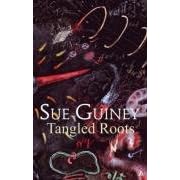 I recently read Tangled Roots by Sue Guiney. (See at Amazon.co.uk.) This book falls into the interesting category of lab lit - books that feature science or scientists at work, but aren't science fiction.
I recently read Tangled Roots by Sue Guiney. (See at Amazon.co.uk.) This book falls into the interesting category of lab lit - books that feature science or scientists at work, but aren't science fiction.The novel interwines the life of a theoretical physicist and (in earlier years) his mother. I liked it very much for its sense of place. The key locations in the book - New York and Boston, and particularly London, Moscow and two country retreats are almost characters in their own right, and strongly influence characters and plot.
It's a people piece, about the relationships in a family and between friends, and how catastrophes in one life can influence another. I found it engrossing and a really worthwhile read.
Two small things niggled me a touch. One was a longish section on baseball. I've nothing against grown men playing rounders in funny clothes, but I just have zero interest in sport of any kind, so this dragged a little. The other was particularly poor proofing - although this was produced by a professional (small) press, it had really basic errors, like italics rendered as underlines and big gaps in the text where it wasn't properly laid out. This doesn't have any influence on the quality of the writing, but does affect the reading experience.
Don't expect to learn a lot about the holographic universe theory that is the science the physicist is working on - there's rarely much detail, and certainly not enough to scare off those who have the same reaction to science as I do to sport. Instead expect to get inside the heads of some interesting, three-dimensional characters.

Comments
Post a Comment